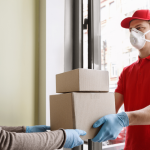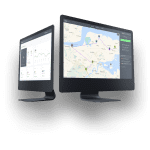Tomorrow’s deliveries, done today! Optimizing your delivery routes gets more done in quicker time while overwhelmingly surprising your customers’ service expectations. GSMTasks is an error-free last mile delivery software for your business. Surprise your customers’ expectation time with last mile delivery software

Last mile delivery software empowers delivery companies to crush their competition without placing further strain on their resources. Last mile delivery software enables delivery businesses to avoid the following:
In today’s highly competitive market it is more vital than ever to begin remodeling your business to compete with the bigger players on the market.
Last mile delivery technology is one such tool to level the playing field.
Home services management software supports vendors against their competition and traditional delivery services. Without route optimization software home services vendors find the following:
To outsmart your competitors, it is more crucial than ever to utilize technology to not only crush the competition but to steal market share.
Last mile delivery is a serious business. Amazon’s nearly same-day deliveries have created a “demand now” customer expectation. Companies who cannot do this will inevitably lose out.
To meet these modern delivery expectations your business must utilize a technology solution that provides a faster route delivery without any delays or errors.
GSMTasks provide a last mile delivery software solution for every kind of delivery service loaded with customizable options to tailor to your business requirements.

Plan optimized multi-stop routes in minutes. GSMtasks routing engine rescues you from hours of manual fleet management planning.

Customizable options including photo capture, GPS tracking, custom meta fields, proof of delivery and much more.

Enter your addresses for the day and the route optimization function provides the most efficient driver route. Automatically optimized routes save substantial fuel and delivery costs.

Recurring tasks can help eliminate the need to schedule the same routes daily and instead get updated automatically.

Manage your team of drivers from your mobile and give them real-time information and ensure task completion on the go.

Extract routing data to boost your business performance. Track only the metrics you need like actual task completion time, average driver delivery time or cost per delivery.
Just insert, upload or copy-paste your location list and GSMTasks does the rest, automatically optimizing your drivers’ routes so you don’t have to. Customers receive their orders quicker meaning you get on doing what you do best – managing your business.

"We started using GSMtasks just at the right time, as we were looking for technician management solutions. GSMtasks was a ready solution to be used and was customised according to Securitas needs."

"Because of GSMtasks route optimization, we have managed to reduce the time spent on logistics up to 2 times."

"Whereas everyone else insisted on having 10,000 features that didn't work, GSMtasks made sure to include only useful features, ensuring that everything runs smoothly"
Remodeling your delivery business has never been easier. To get started streamlining cost and boosting customer satisfaction rates simply:
Last-mile delivery is the final leg of the e-commerce supply chain that physically connects brands with consumers through purchase delivery. Goods are transported from a warehouse or a distribution centre and arrive either at a consumer’s home, business, or parcel locker. For the shipper, last-mile delivery is the most complex and expensive part of the product’s journey.
The goal of superior last-mile delivery is to enable every delivery to reach its destination on time, accurately, efficiently, and sustainably.
The best last-mile delivery software programs have the following functionalities:
Superior last-mile delivery solutions will usually include:
Last-mile delivery is the final step in the supply chain, where goods are transported from a transportation hub or warehouse to the customer’s location. Here’s how it typically works:
Last-mile delivery can be complex, involving navigating challenges such as traffic, limited visibility, and managing returns. However, advancements in technology and new delivery methods, such as drones and autonomous vehicles, are helping to improve last-mile delivery and make it more efficient and cost-effective.
Last-mile operations have never been so complex. Increased variables in how, where and when deliveries depart and arrive give shippers and carriers alike greater flexibility, but they also provide greater complexity to the last mile.
Multiple challenges contribute to the last mile problem. One challenge for shippers and carriers is a lack of efficiency, which contributes to the expense of the last mile. Another challenge is providing real-time visibility regarding a delivery’s location for all stakeholders.
Amazon set the bar high with its ever-increasing ability to deliver in shorter time frames while also notifying the consumer about the transit delivery details. Brands with and without their own dedicated fleets strive to live up to the “Amazon effect,” and adhere to the promised delivery dates and times for consumers.
Consumers want visibility into their deliveries but expect faster delivery speeds. Keeping all stakeholders happy while delivering in increasingly shorter time frames most cost-effectively and efficiently is the last mile problem.
In short, the last-mile delivery problem impacts all companies. In today’s world, every company wants to deliver products quickly, efficiently and provide superior customer experiences while working in an increasingly complex and competitive landscape.
A vehicle tracking system is an electronic device installed within the vehicle to monitor that vehicle’s activity. It’s often paired with fleet management software to simplify fleet tracking.
The most common vehicle data that the system collects are:
Companies that own or lease a fleet of vehicles often invest in vehicle tracking systems to improve the efficacy of their fleets. By using a vehicle tracking system with powerful fleet management software, fleets can:
Last-mile delivery is a complex process that involves several challenges that can impact delivery times, costs, and customer satisfaction. Here are ten common challenges in last-mile delivery:
Last-mile delivery accounts for 53% of the total cost of moving a product across first, mid and last miles. Pinpointing an exact number on last-mile costs is difficult as each delivery differs. However, the average next-day shipping cost for a retailer is $27 per package, while for Amazon, it’s $5.
Test our delivery routing software

Navigate top courier industry problems with our expert guide. Get actionable tips for tackling courier delivery, logistics, and customer service challenges.

Have ecommerce delivery problems? Read our guide on overcoming ecommerce delivery challenges using our ecommerce courier solution.

Explore how eco-friendly delivery and eco-friendly shipping offer eCommerce businesses sustainable solutions to lessen environmental impact.
Just watch your daily operations improve!
Start your free trial No credit card required
The app allows for easy communication between you and your drivers while providing drivers with all of GSMTasks benefits.